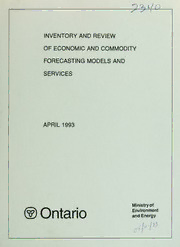
Inventory and review of economic and commodity forecasting models and services PDF
Preview Inventory and review of economic and commodity forecasting models and services
?^'(^^ INVENTORY AND REVIEW OF ECONOMIC AND COMMODITY FORECASTING MODELS AND SERVICES APRIL 1993 ® Ministryof Ontario Environment and Energy .'j-l'O ISBN 0-7778-0514-6 INVENTORY AND REVIEW OF ECONOMIC AND COMMODITY FORECASTING MODELS AND SERVICES APRIL 1993 Cettepublication technique n'est disponible qu'en anglais. Copyright: Queen's Printer for Ontario, 1993 This publication may be reproduced for non-commercial purposes with appropriate attribution. PIBS 2340 INVENTORY AND REVIEW OFECONOMIC AND COMMODITY FORECASTING MODELS AND SERVICES Report prepared for: Economics Office PolicyDevelopment and Intergovernmental Relations Division Ontario Ministry ofEnvironment and Energy Report prepared by: APOGEE Research International TABLE OF CONTENTS 1.0 Background and Purpose l 2.0 Methodology 4 3.0 OverviewofResults 6 4.0 Iron and Steel 7 5.0 Petroleum Refining 8 6.0 Organic and Inorganic Chemicals 9 Model ofEconomic-Energy-Chemicai Interactions (ProbeEconomics Inc.) 10 7.0 Pulp and Paper 13 FORGEM 1.0 (ForestryCanada) 14 EconometricModelofthe Pulpand PaperIndustry (MinistryoftheEnvironment) 17 8.0 Metal Mining 22 SecondarySupplyofCopperand Ferrous Metals (CentreforResourceStudies) 24 ResourceStrategies Inc 26 BrookHunt&Associates Limited 30 9.0 Industrial Minerals 31 10.0 Metal Casting 32 11.0 Energy and Electric Power Generation 33 OntarioMinistryofEnergy 36 OntarioHydro 39 Transportationand ResidentialEnd-UseEnergyDemandModels (Energy,MinesandResources) 43 Industrial SectorTechnologyUseModel (Energy,Minesand Resources) 46 InterfuelSubstitution DemandModel (Energy,MinesandResources) 49 IntegratedModel ofAlberta (EnergyResourcesConservation Board) 52 SERF,MARKALandMarfoekResources 55 12.0 Recreation and Tourism 1.0 Background and Purpose Background: Economic and Commodity Forecasting Models Economicmodelsconsistofoneormoreequationswhichestimatethevaluesofendogenouseconomic variablesasfunctionsofexogenousvariables. Economicmodelsareusedforavarietyofpurposes. Threeoftheirmost importantusesare: • forecasting: predictingthefuturevaluesofeconomicvariables; • simulations: estimatingthe effectsofshocksuponeconomicactivity,and • testingeconomictheory: constructingmodelstoverifyhypothesesregardingtheway economicforcesaredeterminedandinteract. Such modelsmaybeusefultoenvironmental policymakersforsimilar reasons. Specificapplications ofmodelstoenvironmentalpolicyissuesinclude: • forecastingemissionsbyapplyingemissionsfactorstoproductionforecasts; • simulatingtheeconomiceffectsofenvironmentalprotectionmeasuresuponregulated industries;and • estimatingthepotentialbenefitsofenvironmentalregulationsintermsoftouristand recreationalactivities. Eachoftheseapplicationsdemandsmodelswithcertainattributes,perhapsthemostimportantofwhich istheirlevelofaggregation.Themosthighlyaggregatedmacroeconomicmodelsmayincludeonlyone productionfunction forthe entireCanadian economy. Sincethese modelswere constructedin order toestimatetheimpactofvariouspubUcpoliciesonthemacroeconomy,theyareabletosimulatesome ofthe effects ofenvironmentalprotectionpolicies on awide range ofeconomicvariables. However, forecastsofoutputeffectsattheeconomy-widelevelarelikelyoflimiteduseinpredictingcontaminant emissionsordischarges. Other models provide estimates of output at the sectoral level. Since environmental protection regulationsimpactverydifferentlyupondifferentsectors,sectoraldetailisessentialformanypurposes, includingthosementionedabove. However, even output at the industrial sector level may be too highly aggregated for some of the Ministry's purposes. Since industries are generally defined to encompass at least several products, substantialvariationincontaminantdischargesmayexistbetweenproductionunitswithineachsector. For example, a model ofthe pulp and paper industrymay disaggregate the sector by production of newsprint,woodpulp,paperboard, etc. Aseparateemissionscoefficient foreachproductwouldallow forecasts oftotalcontaminantdischargestofluctuatewiththecomposition ofeachsector'soutput. A final level of disaggregation, namely by type of production process, has also been shown to be significantinprojectingemissionloadings. Significant differencesinemissionsoftenoccurasaresult 1.0 BackgroundandPurpose ofdifferences in technology employed. Tliis implies that the ideal data set to forecast contaminant emissionsshouldalsoincludecommodityforecastsbyproductionprocess. The Ministry's Use ofthese Models TheMinistryuseseconomicandcommodityforecastingmodelsfortwomainpurposes: • to simulate the economic effects of enviroiunental protection measures upon regulated industriesandothersectors; and • to forecast emissions of pollutants of concern by applying emissions factors to predicted production,withtheproductionforecastsbeingderived(implicitlyorexpUdtly)fromeconomic and/orcommoditymodels. An example ofthe first use is the Ministry's analysis ofthe effects on the Ontario pulp and paper industryofincreasedenvironmentalprotectionmeasures. An example ofthe second useis presented in Exhibit 1.1, which isa simplified overviewofhowthe Ministry'sAirResourcesBranchestimatescurrent and future emissions ofinterest. Itis instep5of thisexhibitthatMinistrystaffestimatethefuture emissionsofpollutants,anditisthisstepthatcould benefit fromtheuse ofeconomicandcommodityforecastingmodels. Purpose Therangeofmacroeconomicandcommodityforecastingmodelswhichcouldpotentiallybeusedbythe Ministry is quite broad. Moreover, the uses, appUcations and complexities ofthese tools have been increasingrapidly. WhattheMinistryrequiresisaclearerunderstandingoftheavailabilityandnature ofexistingmodelssoitcanbetterutilizeexistinginformationsoiu-ces. Thepurposeofthisprojectistwofold. • It provides an inventory ofeconomic and commodity forecastingmodels which could or do incorporaterelevantvariablesanddatarelatingtoOntario(ie.economic,enviromnental,energy andtourism). • Second,itassessescriticallyaselectednumberofthesemodelsinordertoprovidetheMinistry withaclearunderstandingoftheattributesofthemodelsmostcloselysuitedtotheMinistry's needs. Asaresult. Ministrypersonnelwillbebetterabletoutilizethemodelstofurthertheirenvironmental economicevaluationneeds. PAGE2
